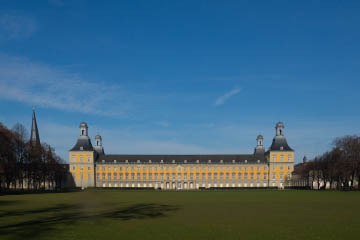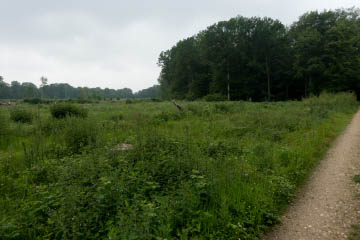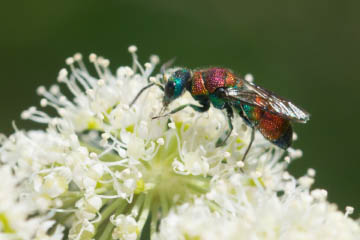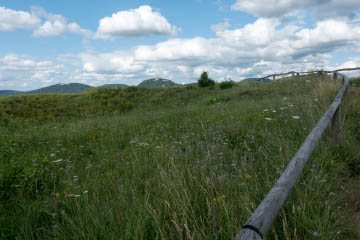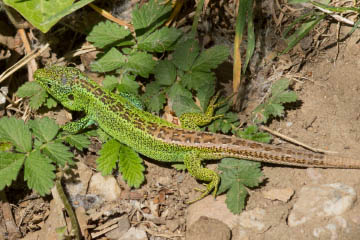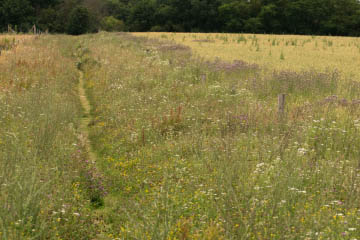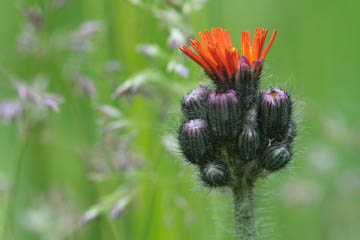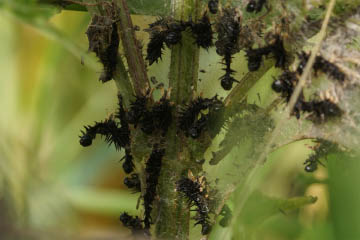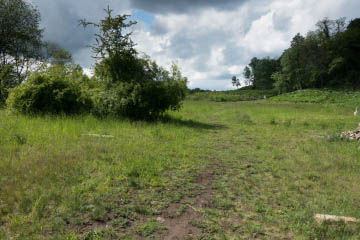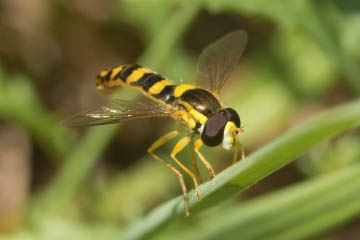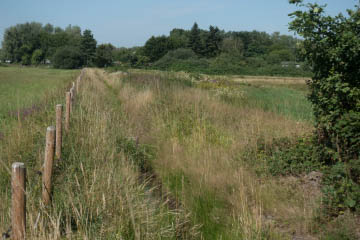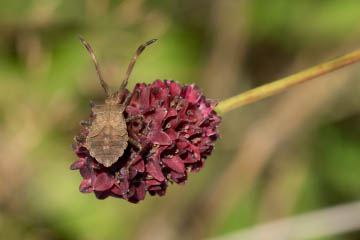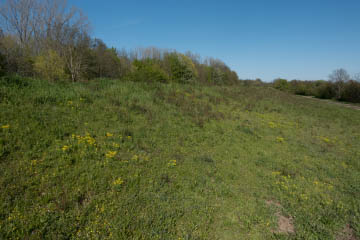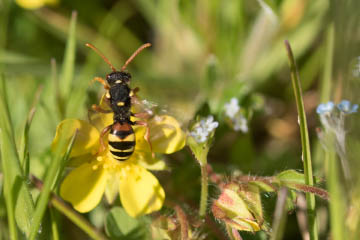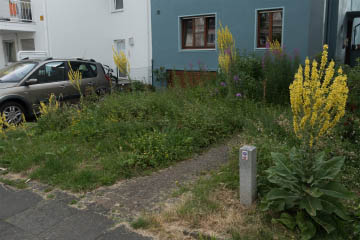Rheinische Friedrich-Wilhelms-University of Bonn
Bonn,  GermanyBonn is actually an ordinary city. However, Bonn,
GermanyBonn is actually an ordinary city. However, Bonn,  GermanyBonn differs from other large cities in one respect: an impressive 23% of the city area is designated as a nature reserve: Thanks to the Kottenforst, North Rhine-Westphalia,
GermanyBonn differs from other large cities in one respect: an impressive 23% of the city area is designated as a nature reserve: Thanks to the Kottenforst, North Rhine-Westphalia,  GermanyKottenforst!
GermanyKottenforst!
This is one reason why in 2025 (comparatively!) many butterfly species occur within the city limits of Bonn,  GermanyBonn: I have been able to photograph a total of 48 butterfly species in Bonn,
GermanyBonn: I have been able to photograph a total of 48 butterfly species in Bonn,  GermanyBonn so far.
GermanyBonn so far.
However, the number is a little deceptive. 35 butterfly species are extinct or lost in Bonn, see Bonn: Species decline.
The large area of the so-called Rheinaue, which was artificially created in the 1970s for the Federal Garden Show, is of little value to the butterfly fauna. The Rheinaue unfortunately has nothing to do with a floodplain. It is primarily a leisure and recreation area, although some (if applicable not always welcome) animal or plant has now found a home there.
Not so long ago, the Kottenforst, North Rhine-Westphalia,  GermanyKottenforst as part of the Ville was of comparatively little interest to me as a butterfly site. And this despite the many impressive old trees, especially OakQuercusOaks.
GermanyKottenforst as part of the Ville was of comparatively little interest to me as a butterfly site. And this despite the many impressive old trees, especially OakQuercusOaks.
You had to be pretty lucky to come across an  Purple EmperorApatura iris (Linnaeus, 1758)Purple Emperor, for example. As a child, I knew places where you could see them in summer. But the Goat WillowSalix capreaPussy WillowGoat Willows there were removed many years ago and the former gravel path was tarmaced and turned into a road.
Purple EmperorApatura iris (Linnaeus, 1758)Purple Emperor, for example. As a child, I knew places where you could see them in summer. But the Goat WillowSalix capreaPussy WillowGoat Willows there were removed many years ago and the former gravel path was tarmaced and turned into a road.
Fortunately, however, the situation has improved in recent years:
- Parts of the Kottenforst, North Rhine-Westphalia,
 GermanyKottenforst were designated as a natural forest and have developed splendidly since then.
GermanyKottenforst were designated as a natural forest and have developed splendidly since then.
- Many areas of the Kottenforst, North Rhine-Westphalia,
 GermanyKottenforst have been renaturalised. Ponds have been (and are still being) created and paths rebuilt. WillowSalixWillows and PoplarPopulusPoplars (important food plants for butterfly caterpillars) were allowed to flourish again.
GermanyKottenforst have been renaturalised. Ponds have been (and are still being) created and paths rebuilt. WillowSalixWillows and PoplarPopulusPoplars (important food plants for butterfly caterpillars) were allowed to flourish again. - The bark beetle has destroyed large areas of ecologically barely valuable commercial forest. Where previously spruce monocultures (in the nature reserve!) caused biological species poverty, there are now (at least for the time being) thriving insect paradises with a great diversity of species. Reforestation with native deciduous tree species also has a positive effect on the butterfly fauna.
See also Bonn: Species decline
Cleared forest area in the western Kottenforst
Gold wasp (Chrysididae spec)
Semi-arid grassland on the Rodderberg
Sand Lizard (Lacerta agilis) on the Rodderberg
I have loved visiting the Rodderberg, North Rhine-Westphalia,  GermanyRodderberg since I was a child. It offers a magnificent view of Bonn,
GermanyRodderberg since I was a child. It offers a magnificent view of Bonn,  GermanyBonn and the Siebengebirge, North Rhine-Westphalia,
GermanyBonn and the Siebengebirge, North Rhine-Westphalia,  GermanySiebengebirge as well as great nature (especially in wetter years!).
GermanySiebengebirge as well as great nature (especially in wetter years!).
I think the area has become even more beautiful in recent years. The fencing off of the dry grassland areas and certain lava patches has been good for plants and animals.
It is rare to see piles of rubbish left behind from parties or plants that have been trampled flat. Most (unfortunately not all) dog owners also adhere to the rules of nature conservation.
Without having to climb over the barriers, you can still take beautiful photos of plants and animals. With a bit of luck, you might even see a  SwallowtailPapilio machaon Linnaeus, 1758Swallowtail in front of your lens.
SwallowtailPapilio machaon Linnaeus, 1758Swallowtail in front of your lens.
Green strip on the northern Röttgen
Fox-and-cubsHieracium aurantiacum L.orange hawk bitdevil's paintbrushgrim-the-collierFox-and-cubs
Fox-and-cubs (Hieracium aurantiacum) near Röttgen
Between Ückesdorf and Röttgen are agricultural fields, which fortunately do not extend to the last centimetre of the paths, but leave a strip about 1 metre wide. This offers a little space for flora and fauna. In 2021, I found half a dozen caterpillar clutches of  PeacockAglais io (Linnaeus, 1758)Inachis ioNymphalis ioEuropean PeacockPeacock ButterflyPeacock's and
PeacockAglais io (Linnaeus, 1758)Inachis ioNymphalis ioEuropean PeacockPeacock ButterflyPeacock's and  Small TortoiseshellAglais urticae (Linnaeus, 1758)Nymphalis urticaeSmall Tortoiseshell's on Nettle FamilyUrticaceaeNettle Family.
Small TortoiseshellAglais urticae (Linnaeus, 1758)Nymphalis urticaeSmall Tortoiseshell's on Nettle FamilyUrticaceaeNettle Family.
On the northern edge of Röttgen (Am Hölder), a new development area was developed a few years ago and compensation areas with meadows and flower strips were created. These also form valuable, popular habitats for insects.
The city of Bonn provides information at the compensation area with a sign:
This is a compensation area.
It primarily serves as a habitat for plants and animals
The background: New construction areas encroach on nature. The soil is sealed so that rainwater can no longer seep away and the microclimate is changed.
Habitats for plants and animals are lost through the destruction of arable land, meadows, shrubs and trees.
For this reason, the German Building Code requires that this intervention in nature and the landscape be compensated for by creating new biotopes.
This area is such a compensation area.
We have taken space away from nature, and here we are giving birds, butterflies, beetles and the like a piece of nature back.
 PeacockAglais io (Linnaeus, 1758)Inachis ioNymphalis ioEuropean PeacockPeacock ButterflyPeacock
PeacockAglais io (Linnaeus, 1758)Inachis ioNymphalis ioEuropean PeacockPeacock ButterflyPeacock
Dead caterpillars of the Peacock's (Aglais io) on a field path near Ückesdorf
On a dirt track between Röttgen and Ückesdorf, several clutches of Nettle Family (Urticaceae) caterpillars of Peacock's (Aglais io) were found. Unfortunately, all the caterpillars in the clutches were dead. This was probably the result of the use of pesticides in the neighbouring fields.
In spring 2022, I again found several clutches of lively caterpillars of  Small TortoiseshellAglais urticae (Linnaeus, 1758)Nymphalis urticaeSmall Tortoiseshell's at the edges of fields.
Small TortoiseshellAglais urticae (Linnaeus, 1758)Nymphalis urticaeSmall Tortoiseshell's at the edges of fields.
A few weeks later - the  Small TortoiseshellAglais urticae (Linnaeus, 1758)Nymphalis urticaeSmall Tortoiseshells had long since become a adult butterfly - I then saw clutches of
Small TortoiseshellAglais urticae (Linnaeus, 1758)Nymphalis urticaeSmall Tortoiseshells had long since become a adult butterfly - I then saw clutches of  PeacockAglais io (Linnaeus, 1758)Inachis ioNymphalis ioEuropean PeacockPeacock ButterflyPeacock's in the same place. Unfortunately, all the caterpillars in these clutches were dead. Apparently they had died suddenly and at the same time. I assume that this was due to the use of pesticides on the neighbouring barley-covered fields.
PeacockAglais io (Linnaeus, 1758)Inachis ioNymphalis ioEuropean PeacockPeacock ButterflyPeacock's in the same place. Unfortunately, all the caterpillars in these clutches were dead. Apparently they had died suddenly and at the same time. I assume that this was due to the use of pesticides on the neighbouring barley-covered fields.
Unfortunately, the Am Hölder areas are mowed too extensively. It would be better to leave out individual areas and mow them at different times.
After I still encountered individuals of  Cyaniris semiargusCyaniris semiargus (Rottemburg, 1775)Polyommatus semiargusCyaniris semiargus,
Cyaniris semiargusCyaniris semiargus (Rottemburg, 1775)Polyommatus semiargusCyaniris semiargus,  Small CopperLycaena phlaeas (Linnaeus, 1761)American CopperCommon CopperSmall Coppers and
Small CopperLycaena phlaeas (Linnaeus, 1761)American CopperCommon CopperSmall Coppers and  Pale Clouded YellowColias hyale (Linnaeus, 1758)Pale Clouded Yellows there in June 2021, I was no longer able to find these species there after all the areas were completely mown shortly afterwards. Even the other formerly very common species, such as the
Pale Clouded YellowColias hyale (Linnaeus, 1758)Pale Clouded Yellows there in June 2021, I was no longer able to find these species there after all the areas were completely mown shortly afterwards. Even the other formerly very common species, such as the  Common BluePolyommatus icarus (Rottemburg, 1775)Common Blue ButterflyCommon Blue, have only been found sporadically since then.
Common BluePolyommatus icarus (Rottemburg, 1775)Common Blue ButterflyCommon Blue, have only been found sporadically since then.
Unfortunately, it can be assumed that the  Cyaniris semiargusCyaniris semiargus (Rottemburg, 1775)Polyommatus semiargusCyaniris semiargus no longer occurs at its only known location in Bonn.
Cyaniris semiargusCyaniris semiargus (Rottemburg, 1775)Polyommatus semiargusCyaniris semiargus no longer occurs at its only known location in Bonn.
On 8 June 2023, I was able to see for myself how the area was completely mowed.
f course the area has to be mowed. However, it seemed to me:
- The beginning of June seems to be an unfavourable time for mowing.
- Complete mowing of the entire area is not very beneficial for birds, butterflies, beetles and the like.
- The mowing machine used is not very insect-friendly.
Despite the perfect weather on this day: apart from two  Meadow BrownManiola jurtina (Linnaeus, 1758)Meadow Browns fluttering around on the tiny unmown areas around a few hedges or small trees, there wasn't a single butterfly to be seen.
Meadow BrownManiola jurtina (Linnaeus, 1758)Meadow Browns fluttering around on the tiny unmown areas around a few hedges or small trees, there wasn't a single butterfly to be seen.
I visited the site again at the end of July: The meadows had grown back and the many colourful flowers were beautiful to look at. However, the plants were all low-growing and despite the reasonable weather, there were no butterflies to be seen apart from a  CommaPolygonia c-album (Linnaeus, 1758)Nymphalis c-albumComma and a few white butterflies. No comparison to the conditions 2 years ago!
CommaPolygonia c-album (Linnaeus, 1758)Nymphalis c-albumComma and a few white butterflies. No comparison to the conditions 2 years ago!
On another visit at the end of August 2023, the picture was unfortunately similar: I only encountered two  Small WhitePieris rapae (Linnaeus, 1758)Small Cabbage WhiteCabbage WhiteCabbage ButterflyWhite butterflySmall Whites and one
Small WhitePieris rapae (Linnaeus, 1758)Small Cabbage WhiteCabbage WhiteCabbage ButterflyWhite butterflySmall Whites and one  Short-Tailed BlueCupido argiades (Pallas, 1771)Everes argiadesTailed CupidShort-Tailed Blue.
Short-Tailed BlueCupido argiades (Pallas, 1771)Everes argiadesTailed CupidShort-Tailed Blue.
However, the decline in individuals and species could also be due to the use of pesticides in neighbouring fields (see above).
At the former old sports ground in Bonn-Oberkassel
Hoverfly at the former old sports field of Bonn-Oberkassel
The meadow at the old Oberkassel sports ground on the Ennerthang (Rauchlochweg) was completely redesigned in 2019 as part of slope stabilisation work. To the north, open areas had already been created and ponds maintained in previous years as part of a nature conservation project, in which the Biologische Station Bonn / Rhein-Erft was also involved.
In 2023, the meadow was fenced off and has not been accessible since then. This was probably due to the many dog owners who walked their dogs in the meadow. It was also possible to cross the meadow between bushes to get to the fenced-off part of the nature reserve, which I have repeatedly observed with late-night walkers. This is no longer possible.Part of the Saure Wiesen in Bonn-Pützchen
A True Bugs (Heteroptera spec) on the Saure Wiesen in Bonn-Pützchen
The Saure Wiesen in Pützchen are home to very special flora and, as a result, special fauna.
In 2021, part of it was declared a nature reserve and cordoned off.
Hedges on the Finkenberg
The Finkenberg,  GermanyFinkenberg is located on the right bank of the Rhine Bonns,
GermanyFinkenberg is located on the right bank of the Rhine Bonns,  GermanyBonns in Beuel.
GermanyBonns in Beuel.
In addition to BlackthornPrunus spinosaSloeBlackthorn and Midland HawthornCrataegus laevigataEnglish HawthornWoodland HawthornMayflowerMidland Hawthorn, there are also some tall oaks on the Finkenberg,  GermanyFinkenberg. The butterfly fauna there is rather modest despite the graceful landscape.
GermanyFinkenberg. The butterfly fauna there is rather modest despite the graceful landscape.
Dam in the Siegauen
Vespinae spec in the Siegauen
The Siegauen are located in the north-east of Bonns,  GermanyBonns and are home to many plants and animals, some of which are rare.
GermanyBonns and are home to many plants and animals, some of which are rare.
In early summer 2021, I even encountered a Northern LapwingVanellus vanellusNorthern Lapwing several times with its unmistakable song and spectacular flight.
The photographer's front garden in Bonn-Kessenich
A grasshopper in my garden in Bonn
My front garden and the garden behind the house are little islands of wildflowers in the centre of Bonn,  GermanyBonn.
GermanyBonn.
It is astonishing to see the variety of insects that have now found their way into the few square metres.
So far I have been able to photograph 18 species of butterflies and several moths here.
In 2021, I even had a visit from a mole and a hedgehog in the front garden.
The front garden attracts a lot of attention. The parents of many children have already praised me and thanked me for the shining children's eyes.
Recommended for imitation! Away with the gardens of horror!
 Camberwell Beauty (Nymphalis antiopa)
Camberwell Beauty (Nymphalis antiopa)






